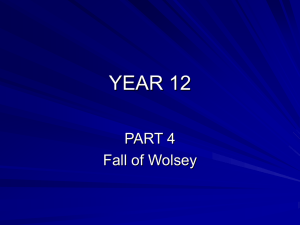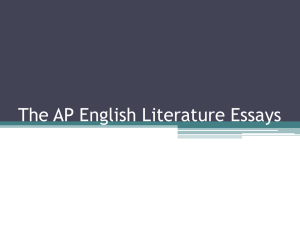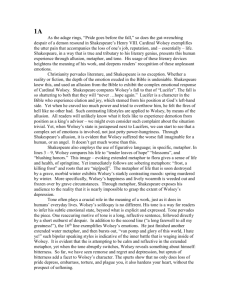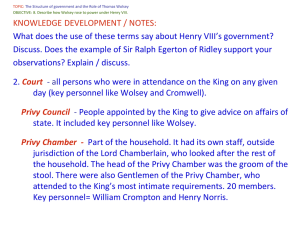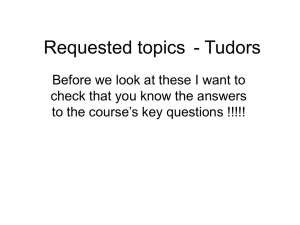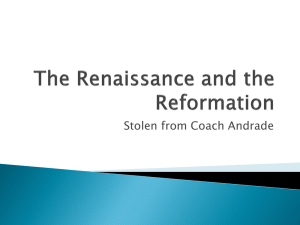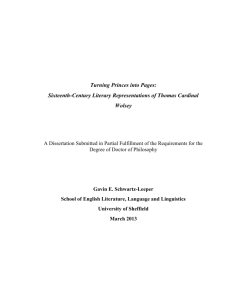Phases 1 and 2 Wolsey`s Failure 1527-29(ppt)
advertisement
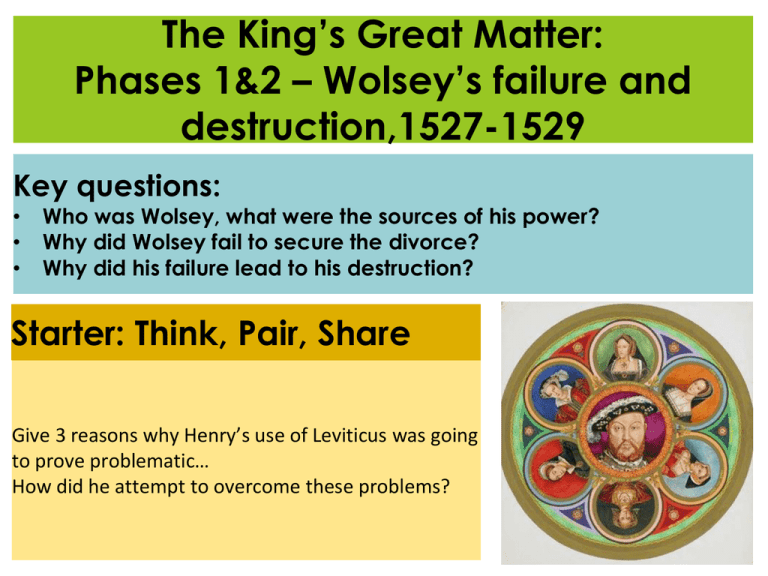
The King’s Great Matter: Phases 1&2 – Wolsey’s failure and destruction,1527-1529 Key questions: • • • Who was Wolsey, what were the sources of his power? Why did Wolsey fail to secure the divorce? Why did his failure lead to his destruction? Starter: Think, Pair, Share Give 3 reasons why Henry’s use of Leviticus was going to prove problematic… How did he attempt to overcome these problems? Who was Thomas Wolsey? • Who was Thomas Wolsey? What was his background? • What were the sources for his power? • Why were both Henry and Wolsey confident that divorce was guaranteed? Who was Thomas Wolsey? What does the poem suggest and why? John Skelton, 1522 Why come ye not to court? To which court To the King’s Court Or to Hampton Court? The King’s Court Should have the excellence But Hampton court Hath the pre-eminence Who was Thomas Wolsey? • • • AF Pollard (1929) – Wolsey servant of pope J Scarisbrick (1968) – Wolsey as peacemaker of Europe Peter Gwyn (1990) – Wolsey servant of Henry • Son of a butcher – but with an expensive education. • Benefitted from Henry VII’s attempts to curb power of nobility – became Royal Chaplain and then appointed to post of ‘Almoner’ in 1509, giving him a seat on the Privy Council in 1511. • Wolsey benefitted from Henry’s disinterest in the minutiae of government… • Energy and resources of first phase of Henry’s reign focussed on futile attempt to reproduce achievements of Henry V in France • April 1512-13 (at a cost of roughly £600,000; roughly 6x the annual income of the crown) Henry’s first campaign in France leads to the capture of Tournai at the ‘Battle of the Spurs’ – Wolsey’s organisation of this triumph led to his rise in Henry’s court; • Wolsey was prepared to speak up for Henry’s belligerent ambitions sees him displace Henry VII’s conservative advisers Richard Foxe (Bishop of Winchester) and William Warham (Archbishop of Canterbury) as advisers to the king. Why were both Henry and Wolsey confident that divorce was guaranteed? • • • • • Wolsey’s Power He is appointed Lord chancellor in 1515, and presides over the emergence of the Court of Star Chamber – and becomes known as a giver of ‘impartial’ justice. • Leads to resentment of him at court. • He plays a role in developing a new tax - the ‘subsidy’ – based on the ability to pay…. this does not help his reputation with nobles. • Wolsey’s attempts, in 1525, to raise money for yet another campaign in France, through the so-called ‘amicable grant’ leads to disturbances. Wolsey the most notorious ‘pluralist’ and ‘absentee’ in Christendom… Shortly after Battle of the Spurs in 1513, Wolsey became Bishop of Tournai, and then Bishop of Lincoln in 1514 and Archbishop of York in the same year. In 1515 he is appointed Cardinal – giving him precedence over archbishop of Canterbury; He became papal legate in 1518 before becoming ‘legate a latere’ from 1524 – literally, ‘legate at the pope’s side’, giving him permanent legatine status to act virtually as the pope’s proxy in England. Cardinal College – later Christ Church, Oxford Magnificence, War, Diplomacy • Wolsey was essentially an OPPORTUNIST • He was not a pacifist (Scarisbrick) – such a judgement is anachronistic • Death of Maximillian in 1519 – succession of Charles V… • Field of Cloth of Gold, 1520 • War against France in 1522 (allied to Emperor) • By end of 1920s allied with France against Emperor. Why did Wolsey fail to secure the divorce? • The king required a dispensation from the pope There were basically three approaches pursued by Wolsey – all of them failing. What were they and why did they fail? Why did Wolsey fail to secure the divorce? Option 1: Leviticus Preferred by Henry – Leviticus 16 v. 2 Why did Wolsey fail to secure the divorce? Option 2: ‘clerical error’ Option 2 – Wolsey wanted to pursue a less direct challenge to papal authority Rather than question the pope’s authority to dispense in this case, Wolsey suggested to Henry that instead they focus their arguments on the wording of the original dispensation which focussed on ‘affinity’. If Catherine was indeed a virgin when she married Henry (as she claimed) then there was no ‘affinity’ so the dispensation ‘missed the mark’ which should have been ‘public honesty’. What were the merits of this approach? Henry never seriously considered this – why is that significant? Why did Wolsey fail to secure the divorce? Option 3: Persuade the pope to allow the case to be decided in England. This was a central part of the strategy adopted by Henry and Wolsey together... Eventually the pope agreed to a compromise – the case should be heard jointly by two papal legates – by Cardinal Campeggio as well as Cardinal Wolsey. This didn’t seem to offer to great a challenge – Campeggio was the absentee bishop of Salisbury and unofficially looked after Henry’s interests at the curia. Cardinal Campeggio Why did Wolsey fail to secure the divorce? Papal delays and compromises December 1527 – negotiations begin in Rome which leads to pope sending Campeggio. BUT Campeggio had been sent by Clement VII with instructions to delay… which began with his journey which was painfully slow. Meanwhile, AB becomes H’s constant companion in court. There is evidence to suggest that she shared in policy making even if she did not share his bed chamber. She is supposed to have lent a book to Henry, either William Tyndale, ‘The Obedience of a Christian Man’ and/or Simon Fish’s Supplication for Beggars - Anne Boleyn Why did Wolsey fail to secure the divorce? What explains the pope’s actions? Pope Clement VII Why did Wolsey fail to secure the divorce? Blackfriars, March-July 1529 March 1529 a court opened in Blackfriars in order to hear the case for the divorce with representations from Henry’s lawyers. Behind the scenes, Wolsey tries to bring pressure on Campeggio, by making clear that he (Wolsey)would be destroyed in the event of failure and the English church would withdraw its allegiance to Rome. Cardinal Lawrence Campeggio Why did Wolsey fail to secure the divorce? Blackfriars, March-July 1529 John Fisher, Bishop of Rochester, spoke up in favour of his Queen - at length (as he had done since 1527) • More extraordinary was the speech of Catherine herself, probably having been coached about the technicalities of the Catherine trial by Campeggio. of Aragon • Shakespeare’s King Henry VIII quoted her verbatim from George Cavendish’s Life of Wolsey. • Why did Wolsey’s failure lead to his destruction? Wolsey’s downfall 23 July – decision was expected but Campeggio announced that the court would be adjourned to Rome to meet in October…. At this point, Wolsey’s credibility with Henry crumbled. Henry had assumed that Wolsey and Campeggio had worked in tandem. Worse was to follow – Henry was summoned to appear in Rome in August, at which Henry was outraged. Wolsey’s banner Why did Wolsey’s failure lead to his destruction? Wolsey’s downfall However, there is an important back story. Wolsey had enemies at court. They despised him for his lowly origins, and his selfaggrandisement. There was anger over the ‘amicable grant’ of 1525, and jealousy within the Privy Council. Wolsey’s arrest and fall from power in October 1529 represented a triumph for the Boleyn faction at court who correctly perceived Wolsey’s personal feelings about the divorce, even if they were wrong to assume that his hostility to Anne and to the divorce explain the his failure to obtain the divorce – the explanation surely lies with the nature of the case and the papacy. Thomas Wolsey Why did Wolsey’s failure lead to his destruction? Boleyn faction There is no doubt that Wolsey was hostile to the divorce, to Anne Boleyn and to her faction – which he perceived as offering a challenge to his power and authority – but historians have found only one example of Wolsey taking action which might be interpreted as designed to prevent the divorce – when he changed his initial view that the divorce could be decided by the Church hierarchy in England to a strongly held conviction that only the pope could give the necessary ruling, but the air of desperation in his diplomatic correspondence with Rome in the years 1528-29 shows a man who is trying to save his skin – not someone who was working against the divorce. Thomas Howard, Duke of Norfolk Why did Wolsey’s failure lead to his destruction? Wolsey’s downfall The adjournment at Blackfriars was the worst possible outcome for Wolsey (whatever his private feelings). Boleyn clients, such as Thomas Howard the Duke of Norfolk (her uncle) and the Duke of Suffolk had been conspiring to bring down Wolsey from as early as 1526 on a charge that Wolsey had misused his legatine powers and had been in breech of PRAEMUNIRE for the last ten years. The leaders of this faction brought a bill of particulars to him and demanded that he sign. These were due to be heard in the Parliament that had been called for December 1529. He did sign - in the expectation that Henry would dismiss it - but secretly struck back at the Boleyn faction by trying to secure from Clement VII a papal interdict against England! Avignon Papacy Why did Wolsey’s failure lead to his destruction? Wolsey’s downfall This was treasonous and would have led to his execution. Already dismissed as Lord Chancellor stripped of his government properties – including Hampton Court – Wolsey was on his way to plead for his life when he died on 29 November 1530 with the words: ‘Had I but served my God with half the zeal as I have served my King, He would not in mine age have left me naked to mine enemies.’ Thomas Wolsey Next phase… Next phase… Wolsey’s downfall marks the end of Henry’s attempts to win his annulment by co-operation with Rome. Keith Randell describes the years 1530-1531 as the ‘years of drift’ but it might equally be said that this marks the point at which Henry goes on the attack. Our assessment of the next phase of the divorce must begin with the parliament that was called for November 1929 and which met seven times between 1929 and 1936. Thomas Cromwell
